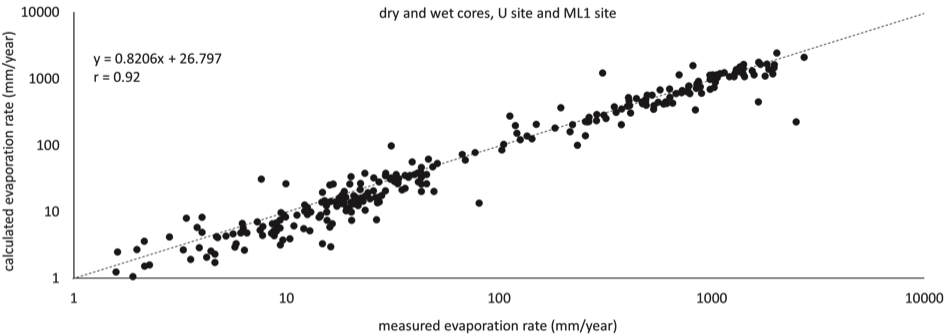 Evaporation from porous rock plays an important role in weathering and biological processes. Despite its importance, evaporation from porous rocks has seen little scientific focus. We present a study on evaporation from bare sandstone, one of the most common rocks affected by weathering. A new method that measures the evaporation rate from the surfaces of sandstone samples under field microclimate was developed and tested. Also, a simple calculation of 1D evaporation rate from bare sandstone surfaces based on Fick’s law of diffusion is presented. The measurement was performed using sandstone cores in a humid continental climate and measured on a roughly monthly interval for about 1 year. For the calculations, a laboratory-measured water-vapour diffusion coefficient of the sandstone, in-situ seasonally measured vaporization plane depth (depth below the surface where liquid water evaporates), and values of air humidity and temperature were used. It was found that the most important factor controlling the evaporation rate was the vaporization plane depth, while seasonal and spatial changes of air humidity and temperature were of lesser importance. The calculated evaporation rate reasonably follows measured values with Pearson correlation coefficient r > 0.81. For its simplicity and the small number of parameters required, the proposed method has the potential to improve knowledge of weathering and living conditions of endolithic and epilithic organisms.
Evaporation from porous rock plays an important role in weathering and biological processes. Despite its importance, evaporation from porous rocks has seen little scientific focus. We present a study on evaporation from bare sandstone, one of the most common rocks affected by weathering. A new method that measures the evaporation rate from the surfaces of sandstone samples under field microclimate was developed and tested. Also, a simple calculation of 1D evaporation rate from bare sandstone surfaces based on Fick’s law of diffusion is presented. The measurement was performed using sandstone cores in a humid continental climate and measured on a roughly monthly interval for about 1 year. For the calculations, a laboratory-measured water-vapour diffusion coefficient of the sandstone, in-situ seasonally measured vaporization plane depth (depth below the surface where liquid water evaporates), and values of air humidity and temperature were used. It was found that the most important factor controlling the evaporation rate was the vaporization plane depth, while seasonal and spatial changes of air humidity and temperature were of lesser importance. The calculated evaporation rate reasonably follows measured values with Pearson correlation coefficient r > 0.81. For its simplicity and the small number of parameters required, the proposed method has the potential to improve knowledge of weathering and living conditions of endolithic and epilithic organisms.
Slavík M., Bruthans J., Weiss T., Schweigstillová J. (2020): Measurements and calculations of seasonal evaporation rate from bare sandstone surfaces: Implications for rock weathering. Earth Surface Processes and Landforms 45, 2965-2981. (DOI)








